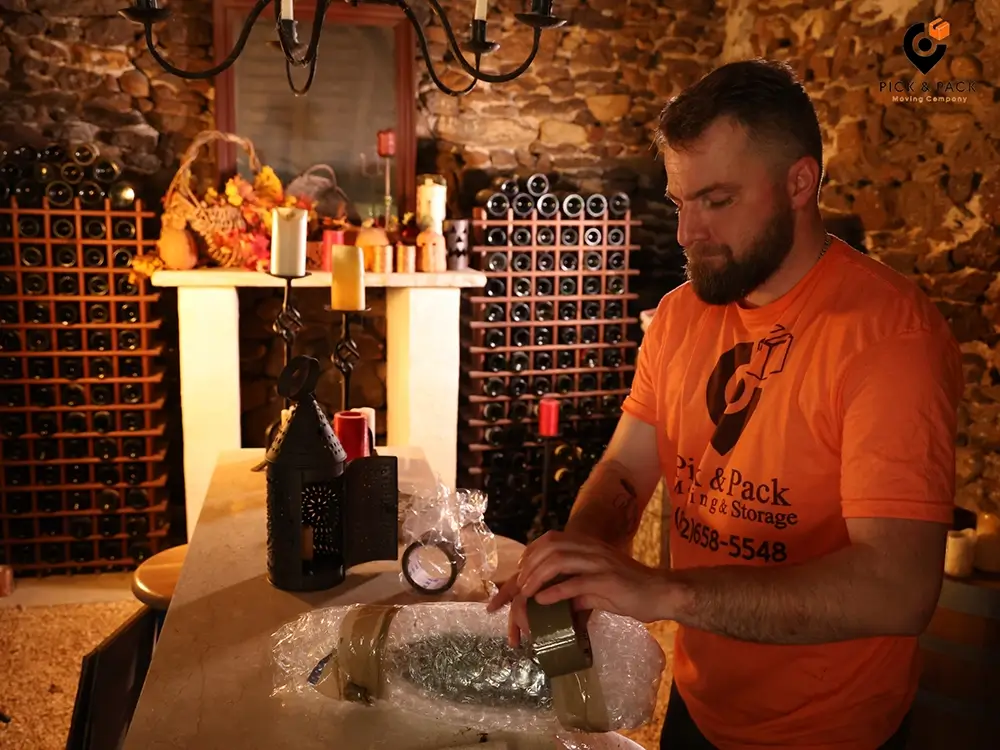
For a wine enthusiast, a collection is more than just bottles - it's a curated library of memories, investments, and future celebrations. The thought of moving it can be daunting. Unlike standard household goods, wine is a delicate, living product that requires specific conditions to preserve its integrity. A single misstep involving temperature swings or rough handling can compromise years of careful aging.
This guide will walk you through the entire process of moving your wine cellar, from initial inventory to post-move resting. Whether you're relocating across town or across the country, these expert moving tips will ensure your prized wine collection arrives at its new home in perfect condition.
Conduct a Comprehensive Inventory of Your Wine Collection
Before any packing begins, knowing exactly what you have is the critical first step. A detailed inventory is your roadmap, essential for insurance purposes, planning the move, and verifying that.
Start by cataloging each bottle. For serious collectors, a spreadsheet or a dedicated wine app is ideal. For each bottle, note:
- Producer and Wine Name: The specific vineyard and wine label.
- Vintage: The year the grapes were harvested.
- Quantity: How many bottles you have of each.
- Estimated Value: Current market or purchase price.
- Location: Its current spot in your cellar or rack.
This high-value inventory form will be invaluable when speaking with your insurance provider and any professional movers you hire.
Pro Tip: This process can go smoother if you work with a professional moving company like Pick and Pack Moving and its professional packers.
Appraise Your Wine for Value and Insurance Purposes
If your collection includes rare vintages or high-value bottles, a formal appraisal may be necessary. Standard moving insurance often has limitations on alcoholic beverages, so understanding the actual value of your collection is crucial for securing adequate insurance coverage.
- When to Appraise: Consider a professional appraisal if your collection is valued over $1,000 or contains investment-grade wines.
- Who Can Appraise: A certified appraiser or a reputable wine merchant can provide documentation of your collection's value.
- Why It Matters: This documentation is your proof of value when discussing insurance policies with your mover or independent insurer, ensuring you can be properly compensated in the unlikely event of damage.
Understand the Legal Regulations for Wine Transportation
Transporting alcohol, especially across state lines, is heavily regulated. It's your responsibility to understand these laws to avoid legal complications.
- Interstate Moves: Laws vary significantly by state. Some states prohibit the importation of alcohol by individuals without a permit.
- Mover Policies: Most standard moving companies are legally prohibited from transporting alcohol. This is a key reason why specialized services are required.
- Solution: A reputable wine moving company will be fully licensed and knowledgeable about the legalities of transporting moving wine collection, providing peace of mind that your move is compliant.
Plan for Insurance Coverage During Transportation
Don't assume your collection is automatically covered. You need to secure a policy that explicitly covers wine during transit against perils like breakage and temperature fluctuation.
- Review Your Policies: Check your homeowner's insurance and discuss options with your mover.
- Specialized Insurance: For valuable collections, you may need a separate valuable articles policy or a rider that covers the wine during the relocation journey.
- Documentation: Have your inventory and appraisal ready to provide to the insurance provider to ensure your coverage limits are sufficient.
Consider Professional Wine Relocation Services
For all but the smallest, most robust collections, hiring experts is the wisest investment. How to move your wine collection is a question best answered by professionals who specialize in this delicate task.
Benefits of Hiring Wine Relocation Experts
Professional services offer expertise and equipment that standard movers do not, including:
- Climate-Controlled Vehicles: Refrigerated trucks or climate-controlled vans that maintain a constant temperature.
- Specialized Packaging: Access to professional-grade wine-specific packing boxes and styrofoam shippers.
- Expert Handling: Training in handling fragile bottles to prevent cork damage and bottle shock.
Selecting a Reputable Wine Transport Company
Choose a company with a proven track record. Look for:
- Specific experience with moving wine collections.
- Positive testimonials from other Wine Enthusiasts.
- Transparency about their storage facilities, vehicles, and insurance policies.
Pro Tip: While Pick and Pack Moving specializes in household moves, we strongly recommend and can help connect you with trusted partners who are experts in moving wine collections. We understand that some items require a professional service with specialized equipment.
Choose Appropriate Packaging Materials
If you decide to pack the wine yourself, using the right packing materials is non-negotiable. Standard moving boxes and newspaper will not suffice.
Types of Protective Packaging for Wine
Invest in purpose-built supplies:
- Divided Wine Boxes: These cardboard boxes have individual cells for each bottle, preventing them from knocking together.
- Styro Shippers: Insulated styrofoam shippers are excellent for protecting against temperature changes during short trips.
- Bubble Wrap: Use plenty of bubble wrap to individually wrap each bottle, providing a cushion against impacts.
Techniques for Securing Bottles during Transit
- Wrap each bottle individually, paying extra attention to fragile Burgundy style bottles.
- Place bottles upright to minimize pressure on the cork during transit.
- Fill any empty space in the box with styrofoam peanuts or packing paper to prevent shifting.
- Clearly label every box as "Fragile" and "This Side Up."
Address Temperature Control Concerns
Temperature is the single greatest threat to your wine during a move. Prolonged exposure to heat or extreme cold can irreversibly damage the wine's flavor and aging potential.
Tools for Maintaining Optimal Temperature
For a DIY move, your options are limited to a cool vehicle and a quick transport time. For a professional move, insist on:
- Climate-Controlled Van: A vehicle that actively maintains a set temperature, typically between 55-60°F.
- Refrigerated Trucks: For long-distance moves, these are essential.
Impact of Temperature Variations on Wine Quality
When wine gets too hot, it "cooks," losing its fruit flavors and becoming flat. When it gets too cold and freezes, the expansion can push the cork out or break the bottle. Consistent temperature control is paramount.
| Temperature Concern | Risk to Your Wine | Professional Solution |
| Heat Exposure | "Cooks" wine, flattening flavors and pushing corks out | Climate-controlled vans maintain stable 55-60°F temperature |
| Freezing Conditions | Can crack bottles and push corks out from expansion | Refrigerated trucks provide heating in cold weather |
| Temperature Fluctuation | Stressful swings degrade wine quality over time | Pre-cooled units with continuous monitoring prevent variations |
| Vehicle Heat Soak | Parked trucks can reach extreme internal temperatures | Professional-grade refrigeration works even during stops |
Pro Tip: The cost of hiring a service with a proper climate-controlled van is minimal compared to the potential loss of a valuable wine collection. When seeking a wine moving company, always ask for details about their vehicle's temperature monitoring and control capabilities. This is a non-negotiable for ensuring quality.
Ensure Proper Handling to Avoid Bottle Shock
"Bottle shock" is a temporary condition where wine becomes muted and disjointed after being jostled during transport. While it usually subsides after a rest period, proper handling minimizes its effects.
- Always transport bottles on their side to keep the cork moist.
- Use a hand truck secured with a ratchet strap to move boxes smoothly, avoiding bumps and jolts.
- Never stack boxes of wine horizontally.
Plan Transportation Logistics in Advance
Careful planning is your best defense against the risks of moving a wine collection. While proper packing and temperature control are essential, without strategic logistics planning, even the most carefully packaged bottles can be compromised. Taking the time to map out the details of your move will ensure your collection transitions smoothly from its current home to its new destination.
Assessing Transportation Distance and Route
The distance of your move directly determines the complexity of the logistics. For a local move within New Jersey, the process is more straightforward. The shorter transit time—often just a few hours—significantly reduces the window for potential temperature fluctuations or handling issues.
However, for a long-distance move, the planning becomes critical. The extended time in transit demands a guaranteed climate-controlled environment and careful scheduling to avoid unnecessary delays or transfers that could expose your wine to risky conditions.
Timing the Move for Optimal Conditions
When you move, it can be just as important as how you move. Seasonality plays a crucial role; it's wise to avoid scheduling your wine move during the peak of summer or the depths of winter. Extreme outdoor temperatures strain climate-control systems and increase the risk of any mechanical issues arising.
Furthermore, consider the day of the week. Scheduling the pickup for early in the week (Monday or Tuesday) helps prevent your collection from being stuck in a storage facility over a weekend, where monitoring may be less frequent. A well-timed move minimizes external risks and keeps your relocation journey on track.
Allow Wine to Rest Post-Transportation
Once your wine arrives at its new home, the journey isn't over. Wine needs time to recover from the stress of travel.
Recommended Rest Period for Settling
Allow your collection to rest in its new wine fridge, Eurocave wine cabinets, or cellar for at least 4-6 weeks before opening a bottle. This allows the sediment to settle and the wine to recover from bottle shock.
Steps for Safely Unpacking Your Wine
- Unpack one box at a time in a cool, calm environment.
- Carefully inspect each bottle for any signs of damage or leakage.
- Gently place the bottles in their new storage, still on their sides.
Verify and Document Your Wine Collection After the Move
Once everything is unpacked, cross-reference your physical bottles with the inventory you created before the move. Check for any broken or leaking bottles and document them with photographs. This final step completes the audit trail for your insurance purposes and confirms a successful move.
When DIY is Too Risky, Entrust Your Collection to Moving Experts
Moving a wine cellar is a complex process that blends careful planning with specialized expertise. While the task may seem overwhelming, you don't have to face it alone.
Choose Pick and Pack Moving for your wine collection. We have:
- Climate-controlled fleet.
- Wine-specific packaging
- Expert handling
- Comprehensive insurance
We treat your collection with the same care we'd give our own, ensuring every bottle arrives in perfect condition, ready for its next chapter - and your next celebration.
Ready to move your wine cellar?





